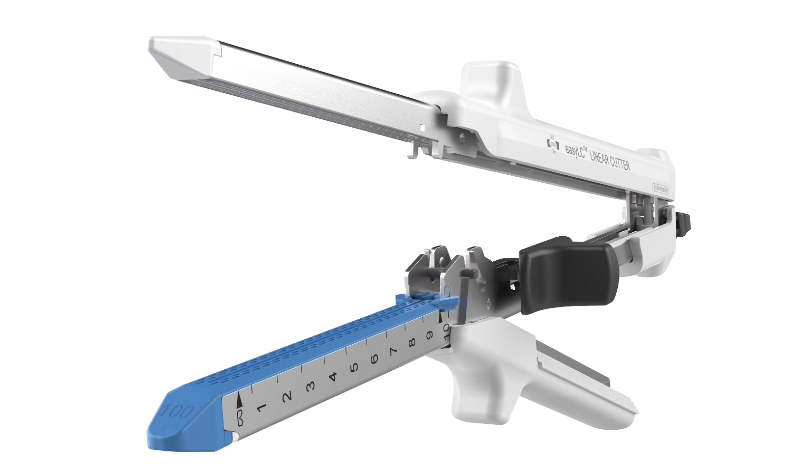Medical staplers and staples are medical devices that can replace sutures. They can close large wounds or incisions more quickly and cause patients less pain than sutures. They are often used in minimally invasive surgeries. They may also be used to close wounds in areas where the skin is pressed against the bone and during surgeries to remove organs or reattach parts of internal organs.
Surgical staplers are usually made of plastic and contain disposable surgical staple cartridges. Staplers come in both reusable and disposable models. They are similar to construction or industrial staplers and are designed to insert and close multiple staples at once.


EziSurg Medical's Surgical Stapling Series products can seal tissue internally during surgery. It is useful in minimally invasive surgery, helping surgeons reduce uncertainty and improve anastomotic performance in general, bariatric, thoracic, and colorectal surgery.
◆Fast: Medical stapler can connect tissues quickly and effectively, reducing surgical time compared to traditional manual suturing.
◆Consistency: EziSurg Medical stapler provides a consistent anastomosis, reducing human error and helping to ensure a strong and stable connection.
◆Reduce Bleeding: The use of medical staplers can reduce the risk of bleeding during surgery because they can achieve hemostasis in the tissue while stapling.
◆Reduces the risk of infection: Staplers can reduce the exposure time of the surgical wound, thereby reducing the risk of infection.
◆Suitable for minimally invasive surgeries: For minimally invasive or laparoscopic surgeries, medical staplers are especially useful because they can complete the stapling work in a smaller space.
◆Improve surgical efficiency: Staplers can improve surgical efficiency, allowing doctors to complete more stapling tasks in a shorter time.

A surgical stapler can be applied in multiple clinical scenarios, such as tissue resection, anastomosis, and wound closure. In laparoscopic surgery, disposable surgical staplers are often preferred due to their convenience and reduced risk of infection. Compared with traditional suturing, a surgical stapler offers precise stapling and reduces operation time.
Our portfolio includes linear staplers, endoscopic staplers, and circular staplers. Each surgical stapler type is designed for specific clinical requirements, ensuring safe and effective outcomes. Surgeons can choose the right device depending on the tissue thickness and surgical approach.
The principle of medical stapler is based on the concept of mechanical anastomosis, which completes the connection of tissues through a series of cleverly designed mechanical structures.
●Opening and positioning: At the beginning of the surgery, the doctor will use the stapler to open it and accurately position it on the tissue site that needs to be stapled.
●Clamping the tissue: There are clamps on both sides of the stapler, which are responsible for clamping the tissue and ensuring the stability of the tissue during the anastomosis process.
●Cutting and hole-forming: Some staplers have cutting blades or hole-forming features to cut or pass through tissue while stapling.
●Staples: A stapler places one or more rows of metal staples (staples) between the tissues. The staples pass through the tissues and connect them tightly together.
●Cut off excess parts: Some staplers also have a scissor function, which is used to cut off excess nail parts to ensure smooth and neat anastomosis.
The surgeon usually completes the entire process by operating the stapler's handle or control device. The design of medical staplers can vary based on specific surgical needs and the site of anastomosis. This mechanical anastomosis method can improve surgical efficiency and reduce surgical time compared with traditional manual suturing.
EziSurg Medical's surgical staplers can be used in surgical procedures such as colectomy, small bowel resection, gastrectomy, lobectomy and wedge resection, covering gastrointestinal, gynecological and thoracic surgery. Our product series include easyLC™, easyEndo™ E-lite, easyEndo™ Lite, easyEndo™ Universal. If you want to know more about our medical surgical staplers, please contact us through the form below. We will contact you as soon as we receive the information.
Related Information
Related Keywords
Enhancing Outcomes in Colorectal Surgery: EziSurg Medical Staple TechnologyGlobal Laparoscopic Devices Market: Trends, Growth, and InnovationsEziSurg surgical innovationsSurgical Stapling DevicesIntestinal Anastomosis StaplerDifferent Types of Staplers Used in Modern SurgeryEndo Linear Cutter StaplerSurgical Stapler ManufacturerUltrasonic vs Electrosurgical Devices: What's the Best Fit for Your OR?Surgical Staple Gun: Understanding the Device and Its Evolving Role in SurgeryEziSurg Medical Staplers: Secure Stapling for Bariatric SurgeryLaparoscopic Surgical Instruments from Ezisurg MedicalAnalysis of Clinical Outcomes Using EziSurg's Minimally Invasive Laparoscopic InstrumentsHow Ultrasonic Energy Enables Cutting and Hemostasis | EziSurg MedicalWhy Choose Disposable Surgical Instruments for Optimal Patient Safety?Linear Stapler SurgicalDisposable vs. Reusable Laparoscopic Instruments: Pros and Cons for HospitalsMedical Stapler ManufacturerEssential Tools Used in Laparoscopic Surgery: A Comprehensive GuideMedical Stapler | Surgical Staplers for MISHow a Single-Use Cystoscope Minimizes Patient Delays: Streamlining Efficiency in Urological ProceduresPowered Staplers for Gastrointestinal Surgery|EziSurg MedicalEndoscopic Linear Cutter StaplersColumn headingsWhat is a Disposable Circular Stapler Used For?How to Choose the Right Surgical Stapler: Types, Criteria, and ConsiderationsSurgical Stapler Pricing AnalysisSurgical Stapling Devices For Sale| The cheapest priceIndications and Key Applications of the easyEndo™ Lite Surgical StaplerEndoscopic Linear StaplerWhat Certifications and Standards Should an Ultrasonic Surgical System Meet?Top Surgical Instruments Manufacturers | EziSurg MedicalEnergy Devices in Minimally Invasive Surgery: Choosing the Right ToolHow EziSurg Designs the Best Minimally Invasive Surgical Instruments for LaparoscopyThe Evolution of Urology InstrumentstestddWhy Disposable Laparoscopic Instruments Are Reshaping Operating RoomsSuture vs. Staple: When to Use Each in Surgical ProceduresWhat is Ultrasonic Surgical System?Benefits of Single-Use Flexible Ureteroscopes in Modern UrologySurgical Stapling Solutions: Advanced Tissue Closure TechnologyEziSurg Collaboration with Top Doctors: Elevating Surgical ExcellenceSurgical Stapler Types | EziSurg Medical Stapling Devices ManufacturerLinear Cutter StaplerEzisurg Endoscopic StaplersHeadquarters (China)
Address
No. 399 Miaoqiao Road, Pudong New District, Shanghai 201315, P.R. China
Phone
+86 400-090-6176
Fax
+86 21-5067-6156
Website
https://en.ezisurg.com
U.S. Subsidiary
Address
Suite 403, 6136 Frisco Square Blvd., Frisco, Texas 75034, USA
Phone
+1 469-252-2118
Or Leave Us a Message, We Will Get Back to You Asap!